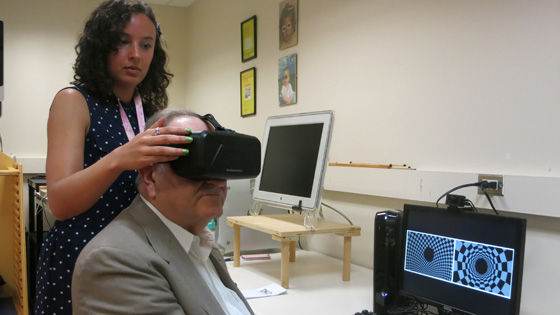
With the help of Taylor Brin (l) Dr. Martin J. Steinbach tries on the Oculus Rift headset. Researchers in his lab will study whether the virtual technology can detect glaucoma.(Photo: UHN)
When it comes to virtual reality (VR), we tend to think of the latest technology that allows gamers a sensory experience of playing video games. But researchers at the Donald K. Johnson Eye Centre at Toronto Western Hospital have a different use for it.
They are leveraging the futuristic equipment to develop a test that could diagnose glaucoma in its early stages.
Related to this story:
Have you ever watched an IMAX movie and felt as though you were moving through the film's scenery instead of sitting still in a theatre chair?
This illusion – where a large moving scene can make the viewer feel like he or she is also moving – is called vection, and is possible because of peripheral vision.
With the help of an Oculus Rift – the leading headset in the field of VR – the research team will test whether impaired vection is an indicator for having glaucoma. Currently, over 250,000 Canadians live with the disease, which is the second most common form of vision loss in people over 40.
"Glaucoma is an eye disease that first affects peripheral vision, but most people don't realize their eye sight is impaired until their central vision is affected," says Taylor Brin, a graduate student working in the lab of Dr. Martin Steinbach.
"By using technology that engages an individual's peripheral vision, we hope to develop a test that detects glaucoma at an earlier stage so an intervention can be prescribed sooner."
Promising results
The research team at the Donald K. Johnson Eye Centre has already published promising results using their own device to stimulate vection.
Study participants sat in front of a large projector screen while a scene of moving dots played on it. Most of those with healthy vision reported feeling vection; however, in 18 patients with mild glaucoma, vection was either impaired or completely absent, as these patients' sensation of motion while viewing the screen was weak or absent.
By using a more immersive technology like the Oculus Rift, the researchers hope to refine their detection of peripheral vision impairment even more.
"Currently, 'early' detection of glaucoma isn't actually occurring in its earliest stage," says Dr. Martin Steinbach, Senior Scientist at TWRI and the principal investigator in the study.
"Standard visual tests don't detect it until the retina has lost a large amount of its neurons. We think that a test focusing on measuring vection might fill this gap."
From video games to research labs
The Oculus Rift is a head-mounted display, and one of the first virtual reality headsets to be marketed to the general public. Developed by a virtual reality enthusiast in 2012, the project soon became a formal company – Oculus VR – that was purchased by Facebook in 2014.
Although the focus of the technology has been for application in video games, it is also being considered to enhance movie going experiences and other social media applications.
"All of the aspects that make the Oculus Rift perfect for gaming are also important for research," explains Brin. "We can use the Oculus Rift's fast frame rate, high resolution, and full-field view to evoke what we hope to be the most compelling and realistic sensation of vection possible."
